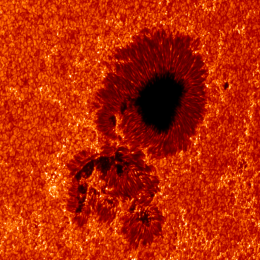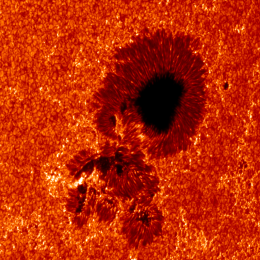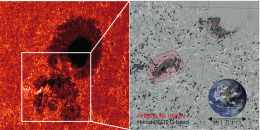Hinode Discovers the Origin of White Light Flare

(PhysOrg.com) -- A joint Japan-United States research team has identified the origin of the white light emission in solar flares.
The team, led by Dr. Kyoko Watanabe, an aerospace project research associate at the Japan Aerospace Exploration Agency, made its discovery by quantitatively analyzing an X-class solar flare, which was observed by two successive, solar-observing satellites: Hinode and the NASA SMEX mission RHESSI. The origin of the white light emission had not been clarified since its first discovery about 150 years ago.

A solar flare is the most energetic explosion observed in the solar system. Different ways of viewing solar flares include X-rays, radio and chromospheric spectral lines. A large percentage of flares are recognized as a result of associated brightening in the visible light spectrum, and thus are called white light flares.
British astronomer Richard Carrington made the first observation of solar flares in 1859 by sketching details of sunspots, including bright features that at times corresponded to white light emissions. However, the occurrence of such emissions is infrequent, leaving the mechanism for their creation unclear.
The Solar Optical Telescope, aboard the solar observing satellite Hinode, provides the white light images, allowing scientists for the first time to accurately study the brightness and its time variations. The Hinode observations completed so far indicate that many solar flares are accompanied by white light emissions. Hinode was launched on Sept. 23, 2006 by JAXA, in partnership with NASA and in collaboration with space-agency partners in the United Kingdom, Norway, Europe and Japan's National Astronomical Observatory.
White light emissions were observed by the Solar Optical Telescope during an X-class flare that occurred at 22:09 UT on Dec. 14, 2006 (see Fig. 1). The RHESSI satellite simultaneously recorded hard X-ray emissions, an indicator of non-thermal electrons accelerated by solar flares. The team found that the spatial location and temporal change of white light emissions are correlated with those of hard X-ray emissions (see Fig. 2). Moreover, the energy of white light emissions is equivalent to the energy supplied by all the electrons accelerated to above 40 keV (~40 percent of the light speed). This finding strongly suggests that highly accelerated electrons are responsible for producing white light emissions.
Hard X-rays are emitted when accelerated electrons impact the dense atmosphere near the solar surface. Normally, white light emissions primarily come from the solar surface, whereas 40 keV electrons can penetrate into the atmosphere about 1,000 km above the solar surface, i.e., the chromosphere.

Particle acceleration is one of the many mysteries surrounding solar flares. Modeling energy transfer of high-energy particles in the solar atmosphere is an important subject for further improving human understanding of particle acceleration. Highly accelerated particles may travel toward the Earth and cause geomagnetic storms, resulting in impacts to Earth-orbiting hardware and human activity on the surface. Now, as solar activity gradually increases after a very long period of minimal high energy activity, solar physicists are hoping the increased solar activity will provide Hinode with additional opportunities to observe solar flares and extend its observations.
More information: “G-band and Hard X-ray Emissions of the 2006 December 14 Flare Observed by Hinode/SOT and RHESSI”, The Astrophysical Journal, No.715, pp. 651-655, 2010.
Provided by JPL/NASA


















